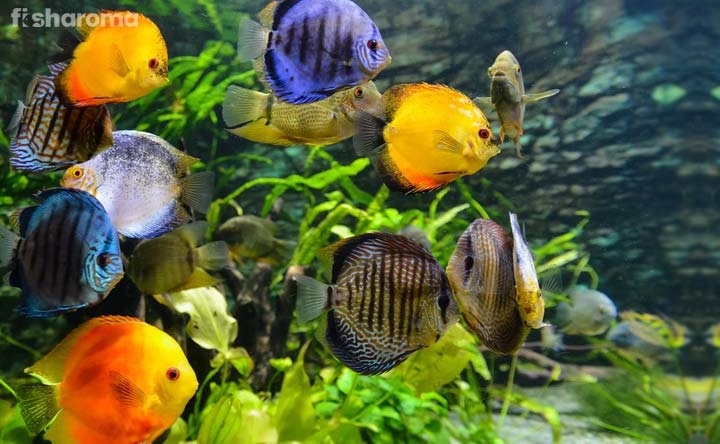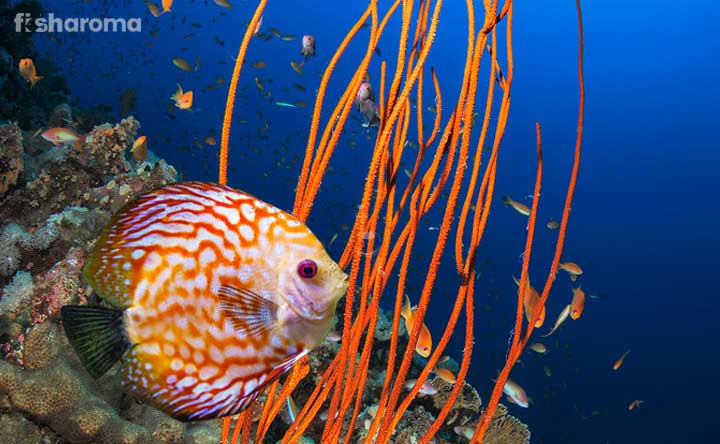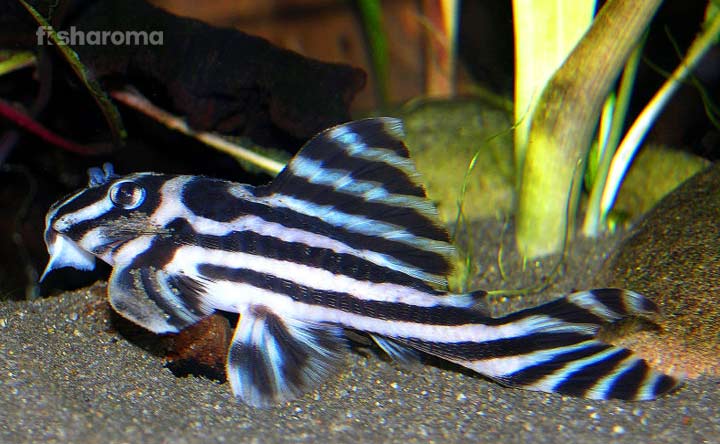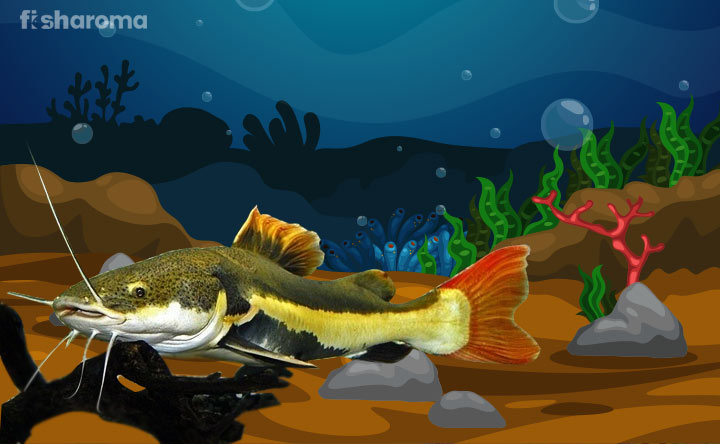Flowerhorn Cichlid – Care Guide for the Humped Freshwater Fish
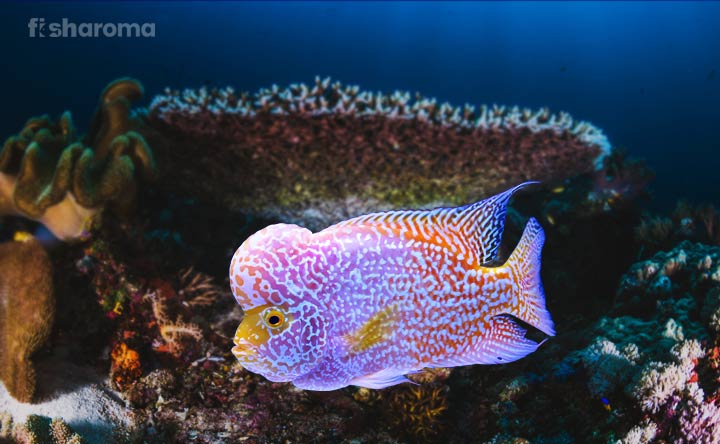
- Origin & Habitat of Flowerhorn Cichlid
- Appearance of Flowerhorn Cichlid
- Behaviour of Flowerhorn Cichlid
- Types of Flowerhorn Cichlid
- Lifespan of Flowerhorn Cichlid
- Diet of Flowerhorn Cichlid
- Tank Requirements for Flowerhorn Cichlid
- Water Type for Flowerhorn Cichlid
- Compatibility of Flowerhorn Cichlid
- Breeding of Flowerhorn Cichlid
- Flowerhorn Cichlid Diseases
- Summary
When it comes to incredible body shapes, very few can match up with the Flowerhorn Cichlids. Their intriguing shapes are a head-turner and add a vivacious dimension to your freshwater tank. We are certain that any fishkeeper would love to host them in their tank. But are they easy to care for? Do they have a peaceful demeanor? Do they have high dietary demands? Is it extremely difficult to breed them? We answer all these questions and more in our all-inclusive care guide for Flowerhorn Cichlid. So, read through!
Key Specifications of Flowerhorn Cichlid
The first step towards preparing yourself for petting a fish is to know about their key specifications, which is exactly what the following table is all about. Take a look!
| Family | Cichlidae |
| Size | Up to 16” (40 cm) |
| Color | Multi-color variants |
| Care Level | Intermediate |
| Lifespan | 10 Years |
| Temperament | Aggressive |
| Compatibility | Low |
| Tank Size | 75-Gallons |
| Diet | Omnivore |
Overview
Apparent from their name, Flowerhorn Cichlids belong to the Cichlidae family. They are the by-products of interbreeding of Cichlids. This stems from the fact that Cichlids do tend to breed with any species of their family, be it their own species or any other species of Cichlid. Interestingly, Flowerhorn Cichlid is a man-made species, which we are going to discuss in detail in the “Origin & Habitat of Flowerhorn Cichlid’ section.
Flowerhorns are also among the largest aquarium fish that you can have in your home. They are mostly easy to care for and are mostly kept by aquarists in their tank as ornamental fish.
Origin & Habitat of Flowerhorn Cichlid
As we have stated above that Flowerhorn Cichlids are man-made species. They were first bred in the year 1993 by Malaysian and Taiwanese fishkeepers because of their fascination of fish with protruding heads. They are an end-result of cross-breeding of several South American Cichlids.
These Fishkeepers bred the Trimac Cichlid and Red Devil Cichlid that were imported to Malaysia from Central America and the hybrid Blood Parrot Cichlid which was imported to Malaysia from Taiwan, and it resulted in the birth of Flowerhorn Cichlid.
However, this is just an accepted belief as reports of them being a by-product of other species such as Redheaded Cichlid, Midas Cichlid, Three Spot Cichlid, Red Terror Cichlid, among others, also exists. The first generation of Flowerhorn Cichlids is called the Hua Luo Han Cichlid.
These fish are domestic by nature and are not found in the wild organically. However, since over the years these fish have been let out in the wild for varied reasons (most probably stemming from the fact that they were becoming too large for home aquariums), a small population of them can be found in some parts of the world.
It is difficult to say what kind of habitat they prefer in the wild. We assume it would be similar to what most other Cichlids prefer. So, keeping that in mind, it can be said that they prefer a tropical environment with warm, hard, slow-moving freshwater. Vegetation is also preferred in the water they live in. So mostly, sheltered riverbed can be said to be the type of habitat these fish reside in the wild.
Appearance of Flowerhorn Cichlid
Probably, the most significant reason for people to host Flowerhorn Cichlids in their aquarium is due to their incredible appearance.
Most of them have elongated bodies that are compressed from both sides; however, some variants have disc-shaped round bodies as well.
They also sport anal and dorsal fins that stretch back to the base of their tail. There are pointed, long braid-like endings to both their anal and dorsal fins. In contrast to that, their pectoral fins are much shorter, but they are extremely elegant and for the most part, transparent. Their caudal fins are rounded and have a spade-like appearance.
The most defining feature of their appearance is their protruding, bulging head that makes them stand out from everyone else. This nuchal hump is also known as ‘Kok’.
Their eyes are deeply planted. They have one nostril on each side in contrast to other fish that have two sets of nostrils. Similar to all other Cichlids, they also have a pharyngeal set of teeth alongside their regular set of teeth.
Sexual Dimorphism
Male Flowerhorns have brighter colors on their bodies than their female counterparts. Apart from having a larger body, the nuchal hump in males is also more defined. The dorsal and anal fins are more pointed in males. The mouths of males are also more pronounced and thick.
Females have black dots on their dorsal fins, which males don’t. The bellies of females are also orange in color, especially right before breeding. Males have papilla while females have a thick visible ovipositor.
Size of Flowerhorn Cichlid
Flowerhorn Cichlids are counted amongst the large Cichlids, and depending on the variant, they can grow anywhere between 12-16” (30-40 cm). They have an amazing growth rate, growing up to 0.7” (2 cm) every month during the first year of their life.
Color of Flowerhorn Cichlid
These freshwater species come in a range of diverse colors. Their scales can be anything from pink to green, metallic to red, yellow to blue, violet to brown, and everything in between. However, the most common color for them is red. Almost all of them have a horizontal black stripe in their bodies.
Buying Guide
While buying a Flowerhorn Cichlid, look for the following features:
- A bulky oval-shaped body with a round abdomen
- The signature nuchal hump
- Bright color
- Pearl scales
- Distinct eyes
- Black horizontal markings
- Erect tails and fins
Behavior of Flowerhorn Cichlid
They are on the aggressive end of the spectrum, a trait commonly seen in members of the Cichlidae family. You will often see them getting in confrontations and fights with other species due to their territorial nature. They are even known to bite the hands of their owners. All in all, they are not the most receptive or friendly to other species, let’s just say that.
They are often seen swimming in pairs, although they are not a schooling fish. In fact, swimming in pairs is said to lower their aggression. Their bulkier bodies tend to slow them down, but that doesn’t stop them from moving up and down the water column.
Types of Flowerhorn Cichlid
Based on their nuchal humps, Flowerhorn Cichlids can be categorized into the following:
- Water Kok
- Hard Kok
- Medium Kok
Flowerhorns can also be classified into various types based on the strains and grades on their bodies as well, such as:
- Kamfa
- Zhen Zhu
- Golden Base Fader
- King Kong Parrot/ Red Ingot
- Thai Silk
- Gold Monkey
- Unique Track
- Coronation Link
- Ancient Warship
- Tornado Effect
- Absolute Wonder
- Legacy
- Perfect Harmony
- Creative Measure
- Royal Degree
- Pacific Miracle
- Exotic Marvel
- Scarlet Passion
- Rising Rainbow
- Quantum Grace
- Living Legend
Lifespan of Flowerhorn Cichlid
If you are planning to host Flowerhorn Cichlids in your aquarium, prepare yourself for dedicating a long-term commitment to them since they are one of the longest-living aquarium species, living up to 8-10 years.
However, short-bodies Flowerhorns have a shorter lifespan than their longer counterparts, living only 4-5 years.
Diet of Flowerhorn Cichlid
Despite being omnivore creatures, they are mostly dependent on a carnivorous diet. They are receptive to both live and frozen foods. It is advised to feed them small quantities of food 2-3 times a day. Provide them that much quantity per meal which they can consume within a minute. Remove any leftover food from the tank to avoid contamination.
Make sure their food is rich in vitamins. Their coloring depends on a healthy diet. You can also feed them high-quality pellets and carotene-enhanced supplements. Keep in mind that they tend to overeat. So, practice caution in this area.
An ideal diet of a Flowerhorn Cichlid should consist of the following items:
- Bloodworm
- Krill
- Earthworm
- Night Crawler
- Cricket
- Sprat
- Spirulina
- Grasshopper
- Mealworm
- Blackworm
- Whiteworm
- Anchovies
- Small crustaceans
Tank Requirements for Flowerhorn Cichlid
Since they are a domestic creature, you don’t have the pressure of replicating their natural habitat from the wild. Still, there are a few points you need to keep in mind, all of which we have mentioned below. So, go through them.
Tank Size
Their large size and territorial nature demand a large-sized tank. For each fish, you need to allot 75 gallons of space, which means if you want to host a pair, then you would need a 150-gallon tank.
Substrate
Try to avoid gravel since large fish are often seen swallowing gravels along with their food. A sand-based substrate is best suited for them. Other than that, you can also include bare bottom or simple pieces of tiles in their tank. If you really want to use gravel, then make sure they are large enough to be not eaten by the Flowerhorns.
Avoid colorful gravels since most of them are made of toxic materials.
Nature of Lighting
Be creative in the usage of LED lights in their tank since they don’t have any specific demands for lighting.
Filter
Since Flowerhorns are large species, it goes without saying that they produce a lot of wastes. This calls for the installation of a strong filter for your tank that will not only clear out the tank but also keep it well-aerated.
A canister filter is recommended for them since it will create a moderate flow of the water, which this fish prefers, as well as keep the water crystal-clean.
Ornaments
You can include some large rocks and driftwood in their tank. Although they are not exactly known for hiding too much, they can use some privacy with the help of these rocks. However, don’t clutter the tank and block their swimming space.
Presence of Flora
Flowerhorns can be destructive towards any live plants, which means this is a strict no-no. They are known for eating up and even uprooting the plants in your aquarium.
Cleaning Method
We can’t stress enough as to how crucial regularly cleaning your tank is. Even if you have a canister filter, it can only do so much. Manual cleaning will help in providing additional care that your fish needs. It will also help maintain the ecosystem inside the aquarium.
Try to clean the tank on a bi-weekly basis. Avoid any chemical or soap-based products. To wipe the interior walls, use lukewarm water and a soft cloth. Use a siphon to vacuum the substrate or you can even put them (along with other ornaments) under running tap water. Also, don’t forget to scrape off algae from your tank.
Water Type for Flowerhorn Cichlid
The type of water that you use for the tank that hosts Flowerhorn Cichlid should have the following parameters.
Temperature
These freshwater species prefer slightly warm water. Thus, keep the temperature of tank water between 80- 89° F (26.7- 31.7° C). To help you do this, get yourself a heater, and if your heater doesn’t come with a temperature reading, install a submerged thermometer in your tank.
pH Level
The pH level of the tank water should be 6.5-7.8, and you should keep a check on it at regular intervals with the help of any pH testing system, such as pH testing strips.
Hardness
The general hardness of the tank water should be between 9-20 dGH.
Mineral Level
These fish are extremely sensitive towards nitrates, nitrites, and ammonia. This is why cycling your tank before introducing your fish to the tank is extremely crucial. Since these fish produce a lot of wastes, chances of toxic in the form of ammonia, nitrite, and nitrate accumulating are extremely high.
Ammonia and nitrite are seen at the start of the cycling, while nitrates are seen at the final stage of cycling. The level of ammonia and nitrite should be 0 (zero), while nitrates should be less than 40 ppm in adult Flowerhorn tanks and less than 10 ppm in tanks that hosts the fries of Flowerhorn Cichlid.
Replacement Procedure
Regular replacement of tank water further helps in ensuring the clean and healthy environment for your fish. Remember, when we say water replacement, we do not mean changing the entire water content altogether. We just mean replacing a percentage of tank water. This is because if you change the entire water, the beneficial bacteria that are needed for cycling the tank will get killed off.
Also, the new water that you add to the tank should be of similar condition as that of the existing tank water in terms of temperature, pH level, and hardness.
The following table will help you get an idea of how much water you need to replace at what time intervals. Pick only one of the following methods.
| Time Interval | Percentage of Water that Needs to be Replaced |
| Weekly (Every 7 days) | 15% |
| Fortnightly (Every 14 days) | 25% |
| Monthly (Every 30 days) | 40% |
Compatibility of Flowerhorn Cichlid
The territorial nature of this fish makes it difficult for them to co-exist. If you can afford a large enough tank where each of your Flowerhorns has at least 75 gallons of water space, then you can keep them together. But, we still recommend keeping a maximum of two of them together.
Suitable Tankmates for Flowerhorn Cichlid
Flowerhorns are compatible with very few species. Cichlids anyways have low compatibility, and the fact that Flowerhorns have been grown domestically, not much is known about which species they are compatible with in the wild. To trace their compatibility, we have to look at the Cichlid species they were bred from.
When selecting their tankmates, go for similar-sized or bigger species that more or less have the same temperament as that of Flowerhorns. Keeping these factors in mind, some of the ideal tankmates for Flowerhorns are as follows:
- Leopard Pleco
- Sailfin Pleco
- Giant Gourami
- Suckermouth Armoured Catfish
- Spotted Raphael Catfish
- Lowland Cichlid
- Bushynose Catfish
- Oscar Cichlid
- Jaguar Cichlid
- Spotted Hoplo
- Pirapitinga
- Large Bichir
Unsuitable Tankmates for Flowerhorn Cichlid
Avoid keeping small, peaceful species with Flowerhorns as they will be attacked by the latter. To be specific, do not include any fish that is less than 10” (25 cm) in size.
In addition, also avoid keeping them with any invertebrates such as Shrimps, Crayfish, or Snails. You also need to avoid fish that are hyper-active because Flowerhorns might get irritated by that.
Breeding of Flowerhorn Cichlid
Although most hybrids are infertile, that is not the case with Flowerhorn Cichlids. The first step towards breeding them is to understand the specific ancestry of your Flowerhorn.
The breeding conditions that a Flowerhorn Cichlid requires are similar to that of the Three Spot Cichlid. Flowerhorns become mature at the age of 1.5-2 years.
For breeding, first and foremost, provide a large breeding tank (55-gallon tank) for them. You then need to provide a couple of hiding spots for the females in the breeding tank so that they can escape the aggression of the males. Get a sponge filter for the breeding tank.
You can also put in a net divider between them with just the bottom elevated enough so that they can communicate without the male squeezing through. However, do this only if the male is exceptionally aggressive. Keep the temperature of the tank water 82° F (28° C) and the pH level of the water 7. Ammonia and nitrite level should be 0 (zero) while the level of nitrate should be less than 10 ppm.
Keep smooth surfaces like ceramics or rocks on which the females will lay eggs. Make sure that you change 10% of the tank water daily so that there is no increased bio-load. In addition, feed them protein and vitamin-rich food multiple times a day.
The males will fertilize the eggs as soon as the females lay them. Both parents can be seen protecting the eggs; however, the males can attack the females thinking the eggs belong to them only. In such a case, separate the males and females.
After Care
The eggs start hatching within 48 hours, and two later, they are able to swim. The newly-hatched fries should be fed baby Brine Shrimps and after a week or so, they can be fed high-quality flake food and/or pellets. You should feed them 4-5 times a day.
The parents generally take care of the young ones for two months, after which you can place them in the main tank altogether. However, watch closely so that other fish do not attack the young ones or the parents. At around six months of age, you can distinguish between males and females.
Flowerhorn Cichlid Diseases
They are a pretty hardy fish and doesn’t require a whole lot of care. The biggest challenge that novice fishkeepers face is the cleaning of the large tank that these fish reside in.
Flowerhorns can cut themselves while digging through the substrate. So, make sure that your substrate doesn’t have any sharp objects. A high sulfur content or lack of oxygen can also cause them serious harm.
They do suffer from fin rot stemming from infection, which is why it is crucial to quarantine everything you put in the tank beforehand, including your pet fish. The other common diseases that are seen in them are hole-in-head disease, intestinal diseases and digestive blockages. Take medical help if your fish suffer from any of these diseases.
Interesting Facts about Flowerhorn Cichlid
- Similar to all other Cichlids, Flowerhorn Cichlid “smell” water by sucking a portion of water and expelling it right back after “sampling” it.
- The back parts of their dorsal, pelvic, pectoral, and anal fins have spiny rays that discourage predators from attacking and eating them.
- Since they don’t have a particular natural habitat in the wild, the careless dumping of these fish by aquarists into their nearby rivers and streams has made them an invasive species in certain areas.
- Females can lay up to 900 eggs at a time.
Summary
If ornamental fish is what you want in your aquarium, then Flowerhorn Cichlids can make for great pets. They are easy to maintain and doesn’t have high dietary or tank requirements. Despite being a man-made hybrid species, these freshwater creatures are a great option for beginner fishkeepers. However, the large tank that they need to survive can pose a challenge to maintain for novice aquarists. But, you can’t get it all, do you? Overall, they are aesthetically pleasing and make for an exotic pet. As long as you follow the correct care guide, you can raise them healthily. One thing we should tell you that they are a living species and not just your object for experiments. So, don’t use them for your odd breeding ideas all the time.
Care Guides of Other Members of the Cichlidae Family
If you are thinking of rearing some other members of the Cichlidae family, take a look at the following care guides:
- Bolivian Ram Care Guide – The ethereal presence of a Bolivian Ram adds a calming effect in your aquarium, which can’t be said about most of the other members of the Cichlidae family.
- German Blue Ram Care Guide – Having a colorful appearance and an aggressive personality, German Blue Rams are a fascinating species.
- Firemouth Cichlid Care Guide – The term ‘fire’ in the name of Firemouth Cichlids refers to both their fiery-orange color and their fiery, aggressive demeanor.




